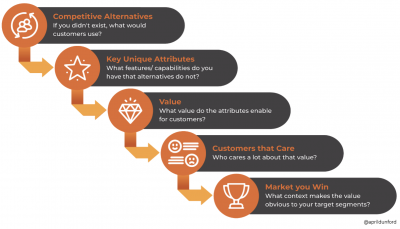Why it is critical to develop the product positioning prior the brand
Often in marketing, developing the brand positioning is critical, but fundamental in this is first getting the product positioning right. Be this in B2C (business to consumer) or B2B (business to business) marketing, yet there can be differences as indicated in our recent research studies.
Much of the research we do is around brand, be it brand concept, campaigns or broader communications. Often in B2C, we measure and explore brand awareness and engagement to increase the likelihood of buying a product. In B2B it’s often in reverse and we need to understand the value that a product brings to a client’s business which is then supported by the brand and the emotional or intangible benefits it brings.
A recent workshop we did with a new B2B client, included directors, sales, marketing, finance, operations and engineers to understand the business complexities and opportunities, solidified some of my thinking around product positioning and why getting the product positioning right is an important step before brand.
Product positioning is fundamentally about what tangible attributes bring value to the customer as opposed to the brand creating an impression or an emotional response. Positioning a product is finding that unique differentiator that says your product is better than alternatives – not just alternative similar products, but potentially in different ways of doing business, or better than even doing nothing. More on that shortly.
This client has an existing (but fairly new) innovative product wanting to sell into a new industry. Not only is the brand relatively new and unknown, the product is likely an ‘early adopter type’ product in a relatively traditional and potentially conservative market.
The client has approached the project in a smart way by wanting to understand the different segments – i.e. types of business operators/owners and structures that may (or may not) see value in this product and as such, who is most effective to target.
The competition is not just other products, but the way targeted businesses operate and their willingness to change and adopt new technologies. Will the investment in this new product be considered a long term strategy to change service offerings for their customers? Will it provide the ability to change a rarely used service that is currently a high cost to customers, towards being a more commonly service at a lower unit price?
Ultimately – how should the sales team approach businesses to illustrate the value that this product could provide. In a recent article I read on frameworks for product marketing, it summarised this exactly – Cutting through the jargon and distilling the complexities of an industry into a clear, understandable arc creates the right context for your product to showcase its most valuable assets.[1]
That’s exactly what our objectives are.
So what is positioning? Positioning expert, April Dunford explains it as:
How your offering is uniquely qualified to deliver value that a well defined set of customers cares a lot about. That is exactly what we need to know. Which segments will care about this product for us to target as priorities?
- What is your competitive alternative
- How you’re different from competitors
- What your differentiated value is
- Who is the value important to – ideal customer profile or target audience
- Market category – what market do you intend to win

In April’s ‘A quick start guide to positioning’ she expands on this to illustrate the relationship between the positioning elements:
So, if every piece has a relationship with every other piece, where do we start?
- competitive alternatives, or what would customers do if our solution didn’t exist. Once we have that, we can ask ourselves, “What do we have that the alternatives do not?”
- That gives us a list of differentiated features or key unique attributes. We can then go down that list and ask ourselves, “So what for customers?”
- Put another way, what is the value those capabilities enable for our buyers?
- Once we understand what our differentiated value is, then we can move to customer segmentation, or who are the customers that care a lot about our value. There is likely a wide range of buyers that care about that value, but certain customers care a lot more than others. What are the characteristics of a customer that makes them care a lot about your differentiated value? That gives us an idea of who our best-fit customers are.
- Lastly, we move to market category. Our best market category is the context we position our product in such that our value is obvious to our target customers. Put another way, it is the definition of the market we intend to win.
The one that most resonates with me for this project is the competitive alternatives. As mentioned, this product could fundamentally change the way these businesses do business. For those who feel their current business models are flying along just fine, how do we overcome the competitive alternative of doing nothing?
April expands on this again below:
Trap 1: Defining competitive alternatives as any possible “competitor”
“The most common mistake I see startups make is in how they define the competitive alternatives in the first step. A better way to think about competitive alternatives is to ask yourself, “What would a customer do if your offering didn’t exist?” Sometimes the answer to that question is “Do nothing.” What that really means is the customer would stick with their current way of solving the problem. That could mean using a spreadsheet, using a manual process, or hiring an intern to do it. In enterprise software, we typically lose 25% of deals to “no decision.” Your positioning needs to position you against the status quo if you want to convince customers to act.“
So now we have the product positioning, where does the brand fit as a product? What else can support the sale of this product along with the team, the innovative technology, the quality etc. Aaker’s brand vision model that brand specialist and team mate Lauren introduced a few weeks ago, describes brand as a product looking at elements like
- Scope
- Attributes
- Quality/ value
- Uses
- Users
- Country of origin
This too fits, exactly into what we need to be looking at.
Then as a final step, the brand position or vision (also explained by Aaker) will support the product.
- Subset of the brand identity and value proposition
- At a targeted audience
- To be actively communicated
- Providing a competitive advantage
So why must we get It right?
Clear positioning helps customers understand the context they need around the product to understand what you offer (context setting). As noted in the Nudge podcast#47 *…. it’s about removing the benefits that customer don’t care about or features they won’t use.
The above mentioned research will give us strong guidance on …
- Clues to determine what you offer
- How much you cost
- How they will use your tool without needing lots of info
*(disclaimer: I do not agree with the title of this podcast but the content is good 😉
Positioning is NOT: messaging, tagline, vision, the ‘why’ as a company or brand. It’s not tactical outcomes from marketing.
Positioning IS a fundamental base layer.
Ultimately, it aims to save the sales team lots of work by setting the context to start – the customer gets what you are, you just need to promote the differentiator.
[1] https://productmarketingalliance.com/a-great-framework-for-product-marketing/




